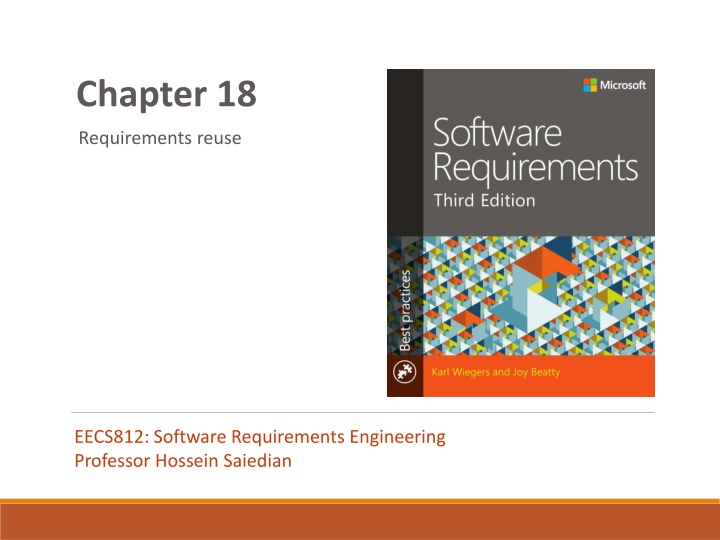
Effective Requirements Reuse in Software Engineering
Discover the benefits of reusing requirements in software development, from faster delivery and cost savings to improved team productivity and reduced defects. Explore the dimensions of requirements reuse, common scenarios, and other opportunities for maximizing efficiency and success in software projects.
Download Presentation

Please find below an Image/Link to download the presentation.
The content on the website is provided AS IS for your information and personal use only. It may not be sold, licensed, or shared on other websites without obtaining consent from the author. If you encounter any issues during the download, it is possible that the publisher has removed the file from their server.
You are allowed to download the files provided on this website for personal or commercial use, subject to the condition that they are used lawfully. All files are the property of their respective owners.
The content on the website is provided AS IS for your information and personal use only. It may not be sold, licensed, or shared on other websites without obtaining consent from the author.
E N D
Presentation Transcript
Chapter 18 Requirements reuse EECS812: Software Requirements Engineering Professor Hossein Saiedian
This chapter will help you to Describe several kinds of requirements reuse Identify some classes of requirements information that have reuse potential in various contexts Perform requirements reuse and discusses issues related in reuse Know barriers to effective reuse and success factors EECS812: Software Requirements Engineering 2
Why reuse requirements ? Faster delivery Lower development costs Consistency Higher team productivity Fewer defects Reduced rework Save review time Accelerate the approval cycle Speed up other project activities EECS812: Software Requirements Engineering 3
Dimensions of requirements reuse EECS812: Software Requirements Engineering 4
How a requirement can evolve through reuse in multiple projects EECS812: Software Requirements Engineering 5
Types of requirements information to reuse Functionality plus associated exceptions and acceptance tests Data objects and their associated attributes and validations Compliance-related business rules Symmetrical user functions Related operations to perform on data objects EECS812: Software Requirements Engineering 6
Types of requirements information to reuse An example EECS812: Software Requirements Engineering 7
Common reuse scenarios Software product lines Common Optional Variant Reengineered and replacement systems Other likely reuse opportunities EECS812: Software Requirements Engineering 8
Other reuse opportunities EECS812: Software Requirements Engineering 9
Requirement patterns A requirement pattern contains several sections Guidance Content Template Examples Extra requirements Considerations for development and testing EECS812: Software Requirements Engineering 10
Tools to facilitate reuse Requirements management tool Traceability links Ideal way Will enhance reuse in several ways Contain large libraries of requirements from certain domains Sharing across multiple projects or baselines possible EECS812: Software Requirements Engineering 11
Making requirements reusable Might not be reusable in its present form Could be specific to a particular project Might be written at too high a level Could be lacking information about exception handling Well-written requirements lend themselves to reuse Reusable requirements must be written at the right level of abstraction and scope EECS812: Software Requirements Engineering 12
Making requirements reusable An example EECS812: Software Requirements Engineering 13
Requirements reuse barriers Missing or poor requirements NIH and NAH Writing style Inconsistent organization Project type Ownership EECS812: Software Requirements Engineering 14
Requirements reuse success factors Repository A single network folder A requirements management tool A database Quality Interactions Terminology Organizational culture EECS812: Software Requirements Engineering 15
Summary The chapter discussed the importance of requirements reuse Different dimensions of requirement reuse Possible reuse scenarios Tools to facilitate reuse Requirements reuse barriers and success factors EECS812: Software Requirements Engineering 16
